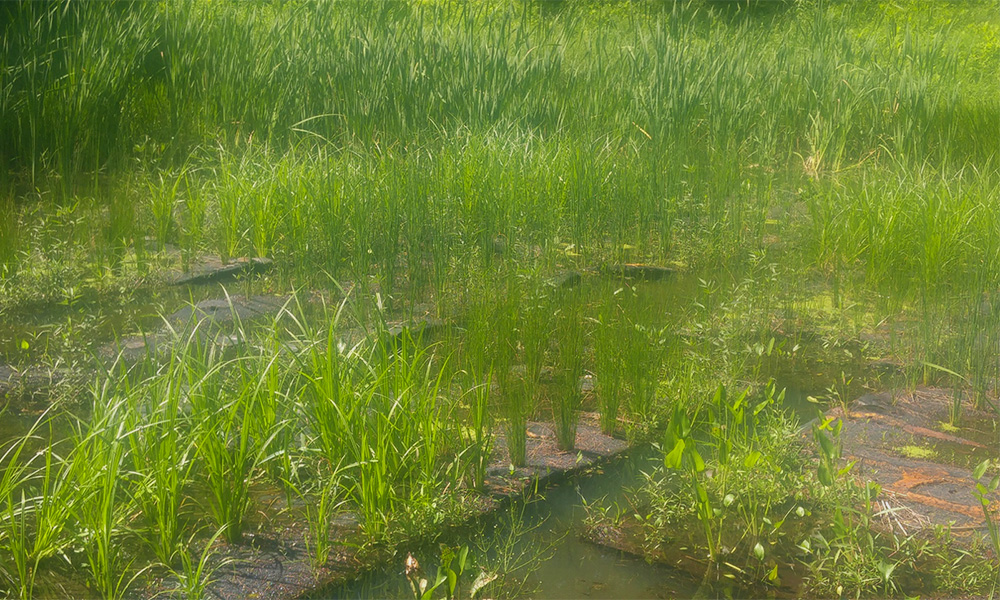Suitability of Plants to Overwinter on Floating Treatment Wetlands in Northern Stormwater Ponds
May. 20th 2020More than likely, you have seen or heard of stormwater ponds, and perhaps you have one near your home or place of work. Stormwater ponds are engineered, small bodies of water that collect and store water that runs off developed land during storm events. These ponds, also called detention basins, help to slow the flow of water off land into waterways. They aid in sediment and nutrient reduction by allowing water to collect and settle out particles before slowly flowing into waterbodies. Stormwater ponds can thus help to reduce pollution and flooding downstream.
However, while stormwater ponds are effective at holding water, they are not as efficient at removing fine sediments and dissolved pollutants, such as heavy metals, hydrocarbons, and dissolved nutrients. A body of recent research suggests that stormwater ponds may, in some cases, release pollutants from previously settled sediment. These pollutants can be detrimental to downstream aquatic habitats and ecosystem health. To combat stormwater pond inefficiency, floating treatment wetlands (FTW) are an experimental retrofit solution to improve the performance of stormwater ponds.
Floating treatment wetlands are vegetated mats that are installed to float on the surface of stormwater ponds and are a promising solution to improve the removal of pollutants. These engineered systems replicate naturally occurring freshwater floating islands, in which plant roots, peat, and organic matter form a buoyant layer that allows these islands to float on the water’s surface. Floating treatment wetlands are designed so that aquatic plants, or macrophytes, can be planted into a floating raft. As the plants grow, their roots extend into the water, and the plants also grow laterally on the raft, increasing surface area and supplying additional water filtration.
These systems can help improve water quality by increasing nutrient uptake, filtering, trapping, and clumping nutrients and other contaminants within the roots of the plants. Floating treatment wetlands therefore have the ability to mitigate the concentration of pollutants entering waterways from urban and suburban development.
However, there is little published research and few field studies on the application of FTW in cold climate regions that experience below-freezing winters and snowy conditions. This has led to their limited application to aid in nutrient and pollutant removal from developed areas in cold climates. A recent study by Rebecca Tharp, Kelly Westhelle, and Stephanie Hurley, in Vermont, addressed this lack of information on the application of cold-climate FTWs through their research on suitability and performance of four macrophyte species in FTWs in the northeastern United States.
The research team looked at characteristics, cold-climate suitability, and performance of four macrophyte species that are native to the Northeast and frequently used in FTW systems. The researchers evaluated cold-climate suitability of the species by their survival rate; development of biomass (volume of plant material); uptake and storage of phosphorus in stems, leaves, and flowers; and root structure. The four plant species included Common Rush, Softstem Bulrush, Longhair Sedge, and Pickerelweed.
Researchers conducted experiments at a stormwater pond that collects runoff from a nearby housing development in South Burlington. The team constructed floating treatment wetlands and installed plants on each raft prior to placing the FTWs in the stormwater pond, with four FTWs for each plant species for a total of 16 rafts and 448 plants. The FTWs were anchored to the bottom of the pond so they were able to float up and down with changes in the water level.
Researchers conducted the experiment from May 2016 to May 2017 and determined winter survival rate from the ratio of the number of living plants at the end of the winter compared to the number at the end of the previous summer. Unexpectedly, the plant Beggar’s Tick also grew on the FTWs, though it was not planted as part of the study, and likely grew from seed on the rafts. This plant was subsequently included in the experiment for biomass and phosphorus content.
Out of all four macrophyte species, Softstem Bulrush and Longhair Sedge best survived winter conditions and sprouted the following spring. However, Softstem Bulrush did not produce much biomass or develop substantial roots, making it is less suitable to trap and collect fine sediment and particles in the root zone. While Pickerelweed performs well in warmer climates, its sensitivity to temperature makes it less suitable for application in FTWs in cold climate regions, even though it had the highest concentration of phosphorus in its stems and leaves compared to all other planted species.
Though it was not intended to be part of the study, Beggar’s Tick performed well in phosphorus uptake and biomass production. But due to its long, thin root structure, it is more suitable for deeper ponds in conjunction with another plant with denser, shorter roots to aid in trapping fine particles. No one species outperformed the others in all categories of evaluation, but overall Longhair Sedge performed better in more categories than the other plants.
This research on the suitability of macrophytes to perform in cold climates has important implications for stormwater management in the state. While one plant species was not superior over the others, this research demonstrates the unique challenges for green infrastructure that Vermont’s cold climate presents and necessitates local research to confirm suitability over harsh winters. With more research on green stormwater infrastructure and a better understanding of the type of plants that will aid in pollutant mitigation in cold climate conditions, Vermont waters can flow toward a future of improved health.
 ecoNEWS VT
ecoNEWS VT